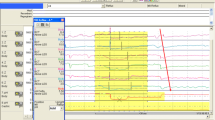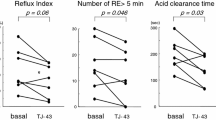Abstract
Some methodological in vitro observations concerning bile reflux monitoring (Bilitec) suggested that Bilitec monitoring is underestimating reflux in an acid environment. Moreover, other studies showed that the area above the cutoff level of bilirubin absorbance would provide an adequate quantitative marker for reflux of duodenal contents. Our aim was to study whether correction for intraesophageal acidity and the area above cutoff during Bilitec monitoring affects the results and the correlation with pH measurement and esophageal lesions. In 84 patients (46 men; mean age 46 ± 2.7 years) evaluated for suspected gastroesophageal reflux disease, we performed ambulatory 24-hr esophageal pH and Bilitec monitoring after an upper gastrointestinal endoscopy. We obtained total area, percent total time, and correction by computer software. The correction factor for bilirubin absorbance was based on literature data for acidified bile (0.06 for pH < 3.6; 0.21 for pH < 2.6). Endoscopy revealed esophagitis grade 1–2 (E1–2) and 3–4 (E3–4) in 23 and 16 patients, respectively. A progressive increase of mixed (acid + bile) reflux occurred with increasing severity of endoscopic lesions (E3–4 vs no esophagitis, P < 0.05). A pathologic Bilitec monitoring result was present in the same 35 patients before and after correction and the correlation between the pH measurement and percent time of bile reflux was not improved by correction for intraesophageal pH (r = 0.386 and r = 0.391; P < 0.05). The total area of bilirubin absorbance above 0.14 (abs × min) was 7.8 ± 2.2 in patients without esophagitis, and 11.7 ± 4.4 and 17.0 ± 4.2 in the E1–2 and E3–4 groups, respectively (E3–4 vs no esophagitis, P < 0.05). The correlation between the Bilitec monitoring and pH measurement regarding percent (r = 0.427, P < 0.01) or area of time below 4 (r = 0.280, P < 0.05) was not improved by considering the area of bilirubin absorbance above the cutoff level. Correction for intraesophageal pH has only a minor effect on the results of ambulatory Bilitec monitoring. Taking into account the surface rather than the percent of time above the cutoff level for bilirubin absorbance does not improve the correlation of Bilitec with acid reflux and with esophageal lesions.
Similar content being viewed by others
REFERENCES
Johnsson F, Joelsson B, Floren CH, Nilsson A: Bile salts in the esophagus of patients with esophagitis. Scand J Gastroenterol 23:712-716, 1988
Gotley DC, Morgan AP, Ball D, Cooper MJ: Bile acid concentrations in the refluxate of patients with reflux oesophagitis. Br J Surg 75:587-590, 1988
Drane WE, Karvelis K, Johnson DA, Silverman ED: Scintigraphic evaluation of duodenogastric reflux. Problems, pitfalls, and technical review. Clin Nucl Med 12:377-384, 1987
Attwood SEA, DeMeester TR, Bremner CG, Barlow AP, Hinder RA: Alkaline gastroesophageal reflux: Implications in the development of complications in Barrett's columnar-lined lower esophagus. Surgery 106:764-776, 1989
Iftikhar SY, Ledingham S, Evans D, Yusuf SW, Steele RJ, Atkinson M, Hardcastle JD: Alkaline gastro-esophageal reflux: dual pH probe monitoring. Gut 37:465-470, 1995
Singh S, Bradley LA, Richter JE: Determinants of oesophageal alkaline pH environment in controls and patients with gastrooesophageal reflux disease. Gut 34:309-316, 1993
Devault KR, Georgeson S, Castell DO: Salivary stimulation mimics esophageal exposure to refluxed duodenal contents. Am J Gastroenterol 88:1040-1043, 1993
Bechi P, Pucciani F, Baldini F, Cosi F, Falciai R, Mazzanti R, Castagnoli A, Passeri A, Boscherini S: Long-term ambulatory enterogastric reflux monitoring. Validation of a new fiberoptic technique. Dig Dis Sci 38:1297-1306, 1993
Vaezi MF, Lacamera RG, Richter JE: Validation studies of Bilitec 2000: An ambulatory duodenogastric reflux monitoring system. Am J Physiol 267:G1050-G1057, 1994
Caldwell MT, Byrne PJ, Brazil N, Crowley V, Attwood SE, Walsh TN, Hennessy TP: An ambulatory bile reflux monitoring system: An in vitro appraisal. Physiol Meas 15:57-65, 1994
Stipa F, Stein HJ, Feussner H, Kraemer S, Siewert JR: Assessment of non-acid esophageal reflux: Comparison between long-term reflux aspiration test and fiberoptic bilirubin monitoring. Dis Esophagus 10:24-28, 1997
Champion G, Richter JE, Vaezi MF, Singh S, Alexander R: Duodenogastroesophageal reflux: relationship to pH and importance in Barrett's esophagus. Gastroenterology 107:747-754, 1994
Caldwell MT, Lawlor P, Byrne PJ, Walsh TN, Hennessy TP: Ambulatory esophageal bile reflux monitoring in Barrett's esophagus. Br J Surg 82:425-426, 1995
Kauer WK, Peters JH, DeMeester TR, Feussner H, Ireland AP, Stein HJ, Siewert RJ: Mixed reflux of gastric and duodenal juices is more harmful to the esophagus than gastric juice alone. The need for surgical therapy re-emphasized. Ann Surg 222:135-136, 1995
Vaezi MF, Richter JE: Role of acid and duodenogastrooe-sophageal reflux in gastroesophageal reflux disease. Gastroenterology 111:1192-1199, 1996
Marshall REK, Anggiansah A, Owen WA, Owen WJ: The relationship between acid and bile reflux and symptoms in gastro-esophageal reflux disease. Gut 40:182-187, 1997
Savary M, Miller G: L'oesophage. Manuel et Atlas d'Endoscopie. Solothurn, Verlag Gassmann, 1977
Armstrong D, Monnier P, Nicolet M, Blum, AL, Savary, M: The “MUSE” system. In The Esophageal Mucosa. R Guili, GNJ Tytgat, TR DeMeester, JP Galmiche (eds). Amsterdam, Elsevier Science, 1994, pp 313-321
Tack J, Koek G, Bisschops R, Sifrim D, Lerut T, Janssens J: Dietary restrictions during ambulatory monitoring of duodenogastro-esophageal reflux. Submitted.
Marshall RE, Anggianah A, Owen WA, Owen WJ: The temporal relationship between esophageal bile reflux and pH in gastro-esophageal reflux disease. Eur J Gastroenterol Hepatol 10(5):385-392, 1998
Author information
Authors and Affiliations
Rights and permissions
About this article
Cite this article
Cuomo, R., Koek, G., Sifrim, D. et al. Analysis of Ambulatory Duodenogastroesophageal Reflux Monitoring. Dig Dis Sci 45, 2463–2469 (2000). https://doi.org/10.1023/A:1005667731289
Issue Date:
DOI: https://doi.org/10.1023/A:1005667731289




